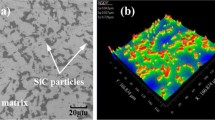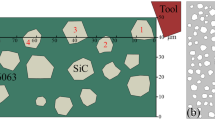Abstract
In order to investigate the influence of reinforcing particles on the machining process and the machined surface, a single-particle turning simulation of particle-reinforced titanium matrix composites (PTMCs) is carried out in this paper. The hard reinforcing phase in the particle-reinforced titanium matrix composites was simplified into elliptical particles, and the machining process and surface under various tilt angles were investigated. The effect of TiC particles with different inclination angles on the formation of pits on the machined surface was investigated and a comparative test was conducted to demonstrate the mechanism of surface crater formation. The results show that the surface quality of the processing is strongly influenced by the inclination angle of the reinforcing particles. When the tool cutting path is located in the center of the elliptical particle, the main axis of the elliptical particle is closer to the X-axis, and the particle fragmentation is more serious and the machined surface quality is worse. As the spindle of the elliptical particle gets closer to the Y-axis, the machined surface quality improves significantly. The breakage mechanism of hard TiC particles during PTMCs was analyzed. The interaction mechanism between the actual breaking process and the variation of cutting force was revealed. When the peak value of cutting force is higher, the state of particle breakage in the substrate becomes more severe. The result of this work has important implications for the subsequent suppression of surface defects and improvement of the machined surface quality.










Similar content being viewed by others
Data availability
The data that support the findings of this study are available from the corresponding author upon reasonable request.
References
Kim C, Cho K, Manjili M, Nezafati M (2017) Mechanical performance of particulate-reinforced Al metal-matrix composites (MMCs) and Al metal-matrix nano-composites (MMNCs). J Mater Sci 52(23):13319–13349
Hayat MD, Singh H, He Z, Cao P (2019) Titanium metal matrix composites: an overview. Compos Part A :Appl Sci 121:418–438
Cao Y, Liu Y, Li Y, Liu B, Xu R (2020) Hot deformation behavior of nano-sized TiB reinforced Ti-6Al-4V metal matrix composites. Mech Mater 141:103260
Liu C, Ding W, Yu T, Yang C (2018) Materials removal mechanism in high-speed grinding of particulate reinforced titanium matrix composites. Precis Eng 51:68–77
Ren Y, Chen P, Li Z, Zhang Z, Lv Y, Zhang C (2021) Effect of strain rate on the mechanical properties of a tungsten particle reinforced titanium matrix composite. J Mater Res Technol 15:984–995
Zhou J, Lu M, Lin J, Du Y (2021) Elliptic vibration assisted cutting of metal matrix composite reinforced by silicon carbide: an investigation of machining mechanisms and surface integrity. J Mater Res Technol 15:1115–1129
Ge Y, Xu J, Huan H (2016) Tool wear during high speed turning in situ TiCp/TiBw hybrid reinforced Ti-6Al-4V matrix composite. Chin J Aeronaut 29(5):1425–1435
Han X, Xu D, Axinte D, Liao Z, Li HN (2021) On understanding the specific cutting mechanisms governing the workpiece surface integrity in metal matrix composites machining. J Mater Process Technol 288:116875
Qiao G, Zhang B, Bai Q, Gao Y, Du W, Zhang Y (2022) Machinability of TiC-reinforced titanium matrix composites fabricated by additive manufacturing. J Manuf Process 76:412–418
Dandekar CR, Shin YC (2009) Multi-step 3-D finite element modeling of subsurface damage in machining particulate reinforced metal matrix composites. Compos Part A :Appl Sci Manuf 40(8):1231–1239
Pramanik A, Zhang LC, Arsecularatne JA (2007) An FEM investigation into the behavior of metal matrix composites: tool–particle interaction during orthogonal cutting. Int J Mach Tools Manuf 47(10):1497–1506
Li Z, Ding W, Liu C, Su H (2017) Prediction of grinding temperature of PTMCs based on the varied coefficients of friction in conventional-speed and high-speed surface grinding. Int J Adv Manuf Technol 90(5):2335–2344
El-Gallab M, Sklad M (2000) Machining of Al/SiC particulate metal matrix composites part III: comprehensive tool wear models. J Mater ProcessTech 101(1):10–20
Sun Y, Zhang C, Ji X, Zhang S, Feng H, Hou Z, Han F (2021) Microstructure evolution of TiBw/Ti composites during severe plastic deformation: Spheroidization behavior. Mater Charact 171:110725
Zhong L, Xu Y, Hojamberdiev M, Wang J, Wang J (2011) In situ fabrication of titanium carbide particulates-reinforced iron matrix composites. Mater Des 32:3790–3795
Shi J, Wang Y (2020) Development of metal matrix composites by laser-assisted additive manufacturing technologies: a review. J Mater Sci 55(23):9883–9917
Fu D, Ding W, Yang S, Miao Q, Fu Y (2017) Formation mechanism and geometry characteristics of exit-direction burrs generated in surface grinding of Ti-6Al-4V titanium alloy. Int J Adv Manuf Technol 89(5):2299–2313
Masanta M, Shariff SM, Roy Choudhury A (2011) Evaluation of modulus of elasticity, nano-hardness and fracture toughness of TiB2–TiC–Al2O3 composite coating developed by SHS and laser cladding. Mater Sci Eng A 528(16):5327–5335
Jianxin D, Zhenxing D, Dongling Y, Hui Z, Xing A, Jun Z (2010) Fabrication and performance of Al2O3/(W,Ti)C+Al2O3/TiC multilayered ceramic cutting tools. Mater Sci Eng A 527(4):1039–1047
Kim Y-J, Yadav P, Hahn J, Xiao X, Lee DB (2019) Oxidation of titanium matrix composites reinforced with (TiB + TiC) particulates. Met Mater Int 25(3):627–632
Feng X, Yan X, Wei Y, Du X (2004) Analysis of extension propagation process of interface crack between belts of a radial tire using a finite element method. App Math Model 28(2):145–162
Funding
The authors gratefully acknowledge the financial support of this research by the National Natural Science Foundation of China (No. 52205475), Natural Science Foundation of Jiangsu Province Universities (No. 16KJB460023), and Six talent peaks project in Jiangsu Province (No. GDZB-064).
Author information
Authors and Affiliations
Corresponding author
Ethics declarations
Consent to participate
All authors know and agree to be co-authors.
Consent for publication
All authors agreed to be published.
Conflict of interest
The authors declare no competing interests.
Additional information
I would like to declare on behalf of my co-authors that the work described was an application that has not been published previously, and not under consideration for publication elsewhere, in whole or in part.
Publisher’s note
Springer Nature remains neutral with regard to jurisdictional claims in published maps and institutional affiliations.
Rights and permissions
Springer Nature or its licensor (e.g. a society or other partner) holds exclusive rights to this article under a publishing agreement with the author(s) or other rightsholder(s); author self-archiving of the accepted manuscript version of this article is solely governed by the terms of such publishing agreement and applicable law.
About this article
Cite this article
Huan, H., Pu, J., Ding, W. et al. Influence of elliptical particle inclination on the formation mechanism of surface defects in turning PTMCs. Int J Adv Manuf Technol 126, 5475–5485 (2023). https://doi.org/10.1007/s00170-023-11470-6
Received:
Accepted:
Published:
Issue Date:
DOI: https://doi.org/10.1007/s00170-023-11470-6




